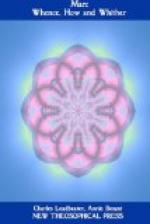The primitive mammals laid eggs like reptiles or birds. Only two genera, echidna and platypus, survive to bear witness of these old oviparous groups, and these only in New Zealand. These retain several old reptilian characteristics. Their lower position is shown also by the fact that the temperature of their bodies is, at least, ten degrees Fahrenheit below that of higher mammals. One of these carries the egg in a pouch on the ventral surface; the other, living largely in water, deposits its eggs in a nest in a burrow in the side of the bank of the stream.
After these came the marsupials. In these the eggs develop in a sort of uterus; but there is no placenta, in the sense of an organic connection between the embryo and the uterus of the mother. The young are at birth exceedingly small and feeble. The adult giant Kangaroo weighs over one hundred pounds; the young are at birth not as large as your thumb. They are placed by the mother in a marsupial pouch on her ventral surface, and here nourished till able to care for themselves.
Pardon a moment’s digression. The marsupials, except the opossum, are confined to Australia, and the oviparous mammals, or monotremes, to New Zealand. Formerly the marsupials, at least, ranged all over Europe and Asia, for we have indisputable evidence in their fossil remains. But they have survived only in this isolated area, and here apparently only because their isolation preserved them from the competition with higher forms. If the Australian continent had not been thus early cut off from all the rest of the world, the only trace of both these lower groups would have been the opossum in America and certain peculiarities in the development of the egg in higher mammals. This shows us how much weight should be assigned to the formerly popular argument of the “missing links.” The wonder is not that so many links are missing, but that any of these primitive forms have come down to us. For we see here another proof of the fearful extermination of lower forms during the progress of life on the globe. It seems as if the intermediate forms were less common among these most recent animals than among the older types. This may not be true, for it is not easy to compare the gap between two mammals with that between two worms or insects, and mistakes are very easily made. But it seems as if extermination had done its work more ruthlessly among these highest forms than among their humbler and lower ancestors. I would not lay much weight on such an opinion; but, if true, it has a meaning and is worthy of study.
In higher, true, placental mammals the period of pregnancy is much longer, and the young are born in a far higher stage of development, or rather, growth. The stage of growth at which the young are born differs markedly in different groups. A new-born kitten is a much feebler, less developed being than a new-born calf. An embryonic appendage, the allantois, used in reptiles and birds for respiration, has here




